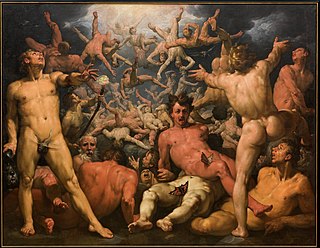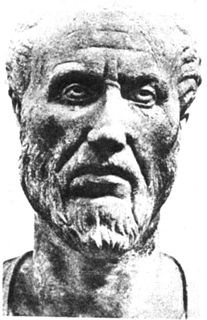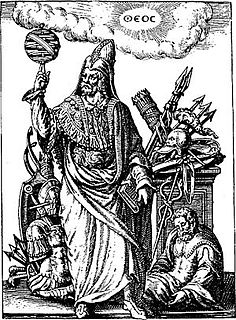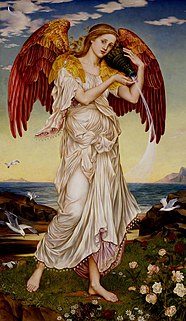
In Greek mythology, Eos is a Titaness and the goddess of the dawn, who rose each morning from her home at the edge of the Oceanus.

Oceanus, also known as Ogenus or Ogen, was a divine figure in classical antiquity, believed by the ancient Greeks and Romans to be the divine personification of the sea, an enormous river encircling the world.
In Greek mythology, the Meliae were usually considered to be the nymphs of the ash tree, whose name they shared.
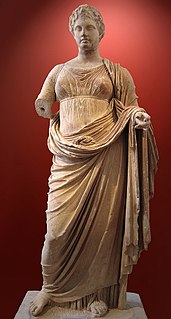
Themis is an ancient Greek Titaness. She is described as "[the Lady] of good counsel", and is the personification of divine order, fairness, law, natural law, and custom. Her symbols are the Scales of Justice, tools used to remain balanced and pragmatic. Themis means "divine law" rather than human ordinance, literally "that which is put in place", from the Greek verb títhēmi (τίθημι), meaning "to put".
In Greek mythology, Coeus was one of the Titans, the giant sons and daughters of Uranus (Heaven) and Gaia (Earth). His equivalent in Latin poetry—though he scarcely makes an appearance in Roman mythology—was Polus, the embodiment of the celestial axis around which the heavens revolve.

In Greek mythology the Horae or Horai or Hours were the goddesses of the seasons and the natural portions of time.

In Greek mythology, Selene is the goddess of the moon. She is the daughter of the Titans Hyperion and Theia, and sister of the sun-god Helios, and Eos, goddess of the dawn. She drives her moon chariot across the heavens. Several lovers are attributed to her in various myths, including Zeus, Pan, and the mortal Endymion. In classical times, Selene was often identified with Artemis, much as her brother, Helios, was identified with Apollo. Selene and Artemis were also associated with Hecate, and all three were regarded as lunar goddesses, but only Selene was regarded as the personification of the moon itself. Her Roman equivalent is Luna.

In Greek mythology, Peitho is the goddess who personifies persuasion and seduction. Her Roman name is Suadela or Suada.
In Greek mythology, Thaumas was a sea god, son of Pontus and Gaia, and the full brother of Nereus, Phorcys, Ceto and Eurybia.

In Greek mythology, Theia, also called Euryphaessa "wide-shining", is a Titaness. Her brother/consort is Hyperion, a Titan and god of the sun, and together they are the parents of Helios, Selene, and Eos. She may be the same with Aethra, the consort of Hyperion and mother of his children in some accounts.
In Greek mythology, Deioneus or Deion is a name attributed to the following individuals:
In Greek mythology, Iapetus, also Japetus, was a Titan, the son of Uranus and Gaia, and father of Atlas, Prometheus, Epimetheus and Menoetius. He was also called the father of Buphagus and Anchiale in other sources.

In ancient Greek religion, Phoebe was one of the first generation of Titans, who were one set of sons and daughters of Uranus and Gaia.
Meander, Maeander, Mæander or Maiandros is a river god in Greek mythology, patron deity of the Meander river in Caria, southern Asia Minor. He is one of the sons of Oceanus and Tethys, and is the father of Cyanee, Samia, Kalamos and Callirhoe.
In Greek mythology, Pallas was one of the Titans. According to Hesiod, he was the son of Crius and Eurybia, the brother of Astraeus and Perses, the husband of Styx, and the father of Zelus, Nike ("Victory"), Kratos, and Bia. Hyginus says that Pallas, whom he calls "the giant", also fathered with Styx: Scylla, Fontes ("Fountains") and Lacus ("Lakes"). Pallas was sometimes regarded as the Titan god of warcraft and of the springtime campaign season.
In Greek mythology, Phaethon was a son of Eos by Cephalus or Tithonus, born in Syria.
In Greek mythology, Electra was the Oceanid daughter of Oceanus and Tethys. According to Hesiod, she was the wife of Thaumas, and by him, the mother of Iris, the messenger of the gods, and the Harpies.
Euryale, in Greek mythology, was the second eldest of the Gorgons, the three sisters that have the hair of living, venomous snakes.
By some accounts described in Greek mythology, Cephalus (; Ancient Greek: Κέφαλος Kephalos was an Athenian son of Hermes and Herse. His great beauty caused Eos to fall in love with him. He was eventually carried off and ravished by her in Syria. Consorting with the goddess, by some accounts Cephalus became the father of Tithonus, the father of Phaethon. In some accounts, he was the son of Hermes by Creusa or of Pandion while Phaeton was said to be his son instead of Tithonus.

Aeschylus was an ancient Greek tragedian. He is often described as the father of tragedy. Academics' knowledge of the genre begins with his work, and understanding of earlier tragedies is largely based on inferences from his surviving plays. According to Aristotle, he expanded the number of characters in the theater and allowed conflict among them; characters previously had interacted only with the chorus.
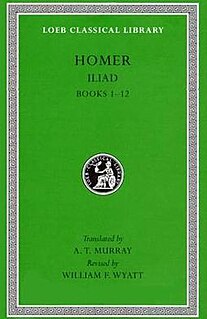
The Loeb Classical Library is a series of books, today published by Harvard University Press, which presents important works of ancient Greek and Latin literature in a way designed to make the text accessible to the broadest possible audience, by presenting the original Greek or Latin text on each left-hand page, and a fairly literal translation on the facing page. The General Editor is Jeffrey Henderson, holder of the William Goodwin Aurelio Professorship of Greek Language and Literature at Boston University.

Harvard University Press (HUP) is a publishing house established on January 13, 1913, as a division of Harvard University, and focused on academic publishing. It is a member of the Association of American University Presses. After the retirement of William P. Sisler in 2017, the university appointed as Director George Andreou.




